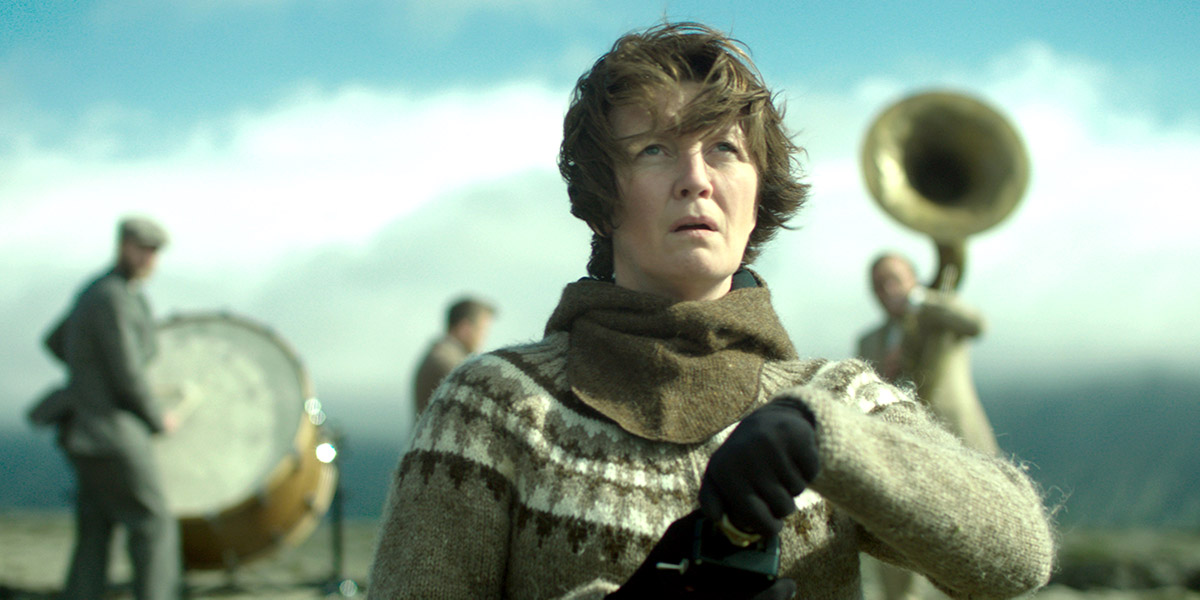The country of Iceland is perhaps best known for two things: Björk and its jaw-dropping landscapes. Though this idyllic little republic occasionally cameos as another planet in films like “Prometheus” and “Interstellar,” it rarely gets to show its own face on the big screen, whether in terms of authorship or setting. “Woman at War” by Benedikt Erlingsson bucks convention by offering Iceland – and a few other characters – a starring role in its epic tale of one woman’s quest for environmental justice.
READ MORE: Toronto International Film Festival: 22 Most Anticipated Movies
“Woman at War” opens on Halla (Halldóra Geirharðsdóttir), a 49-year-old woman with a stern face and a closet full of practical Icelandic wool, as she sabotages a rural power line. A choral director by day, Halla has been running a one-woman resistance against Iceland’s encroaching aluminum industry in her downtime. As a documentary conveniently playing in the background of a domestic scene explains to the viewer, our world is dying and humans are doing little to stop it. Halla has clearly taken this message to heart. What she has done, before the film’s opening credits even have a chance to roll, is shoot down a major power line with a crossbow. The proof is immediately in the rice pudding: This woman is a badass.
Even more satisfyingly, she is a badass that strongly plays against type. It’s rare enough to see older women in cinema, and more so to see them as weapon-wielding heroines. Unlike her cinematic sistren, she is also quite multidimensional: Though severe and intent while sabotaging industrial giants, friends and family know Halla as a warm, supportive mother-to-be, and her relationship with her granola twin sister, Ása (also Geirharðsdóttir), is particularly lovely. When Halla hears she’s next in line to adopt Nika (Margaryta Hilska), a Ukranian orphan, she decides it’s time to hang up her vigilantism – but only after one final heist.
There are so many delightful things about “Woman at War.” Halldóra Geirharðsdóttir is superb as both Halla and Ása (I even believed her a twin until the final credits), and its script is at once plucky and sobering. But the film’s biggest boons are its stylistic quirks and unapologetic Icelandic-ness. Not only does “Woman at War” revel in its breathtaking location, it leans fully into Icelandic culture – so gleefully that even I, a one-time tourist to the country, could pick up what they were putting down. Sheep abound, and rolling green hills and ice-blue glaciers offer Halla refuge while on the lam. Everyone knows or is related to everyone else. A hapless tourist routinely forgets to stay in his lane. A handful of moss is the key player in a dramatic scene, for Thor’s sake. The only way to make this film more self-celebratory would be to watch it in the middle of a fish stew eating contest while enjoying the freedoms of public education and healthcare.
The film’s next-best asset is its quirky manipulation of the fourth wall, which is often being kicked down by a jolly man wielding a tuba. Original music by Davíð Þór Jónsson is almost always diegetic, with winking cues played in and out by actual on-screen musicians as Halla walks by (or, on occasion, directly prompts them to play). Far from wearing out its Wes Andersonian welcome, this device becomes an endearing earmark as the plot strides on. A trio of female Ukranian vocalists duets with a three-piece Icelandic band, each of them reflecting Halla’s warring desires for environmental justice and motherhood. By the end of the film, stamping down your emotional reaction to their haunting warbles or stirring percussions is about as easy as paying $10 for dinner in Reykjavík.
Though occasionally lagging and narratively patchy (we could stand to learn more, for instance, about the titular war), “Woman at War” is an assured second feature from director Erlingsson that cements Iceland’s rightful place in the cinematic canon. Much like Halla’s days of tacit conformity are long past, so too are those of Iceland’s background relegation. As surely as a hiker extending her arms in the middle of an undulating lava field, Iceland has arrived, with a startling movie that’s every bit as idiosyncratic, homely, and dynamic as its country of origin. [B]
Check out all our coverage from the 2018 Toronto International Film Festival here.





